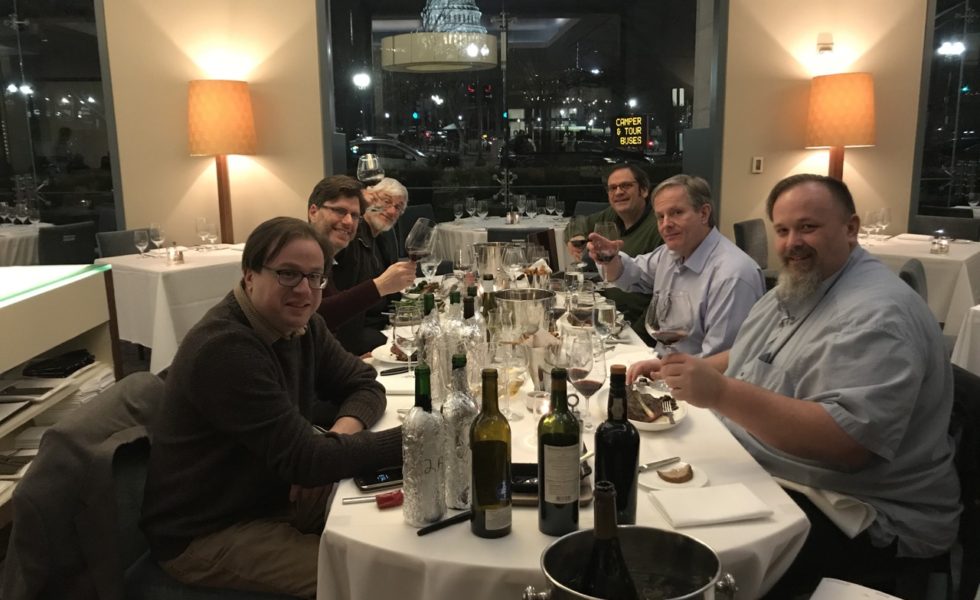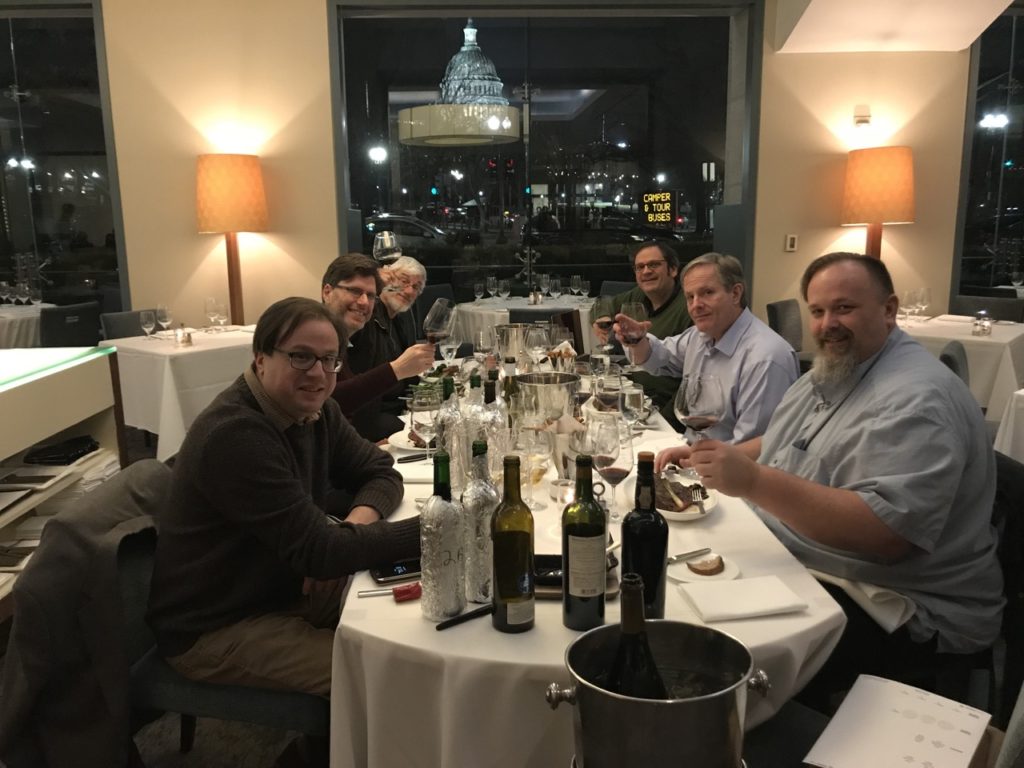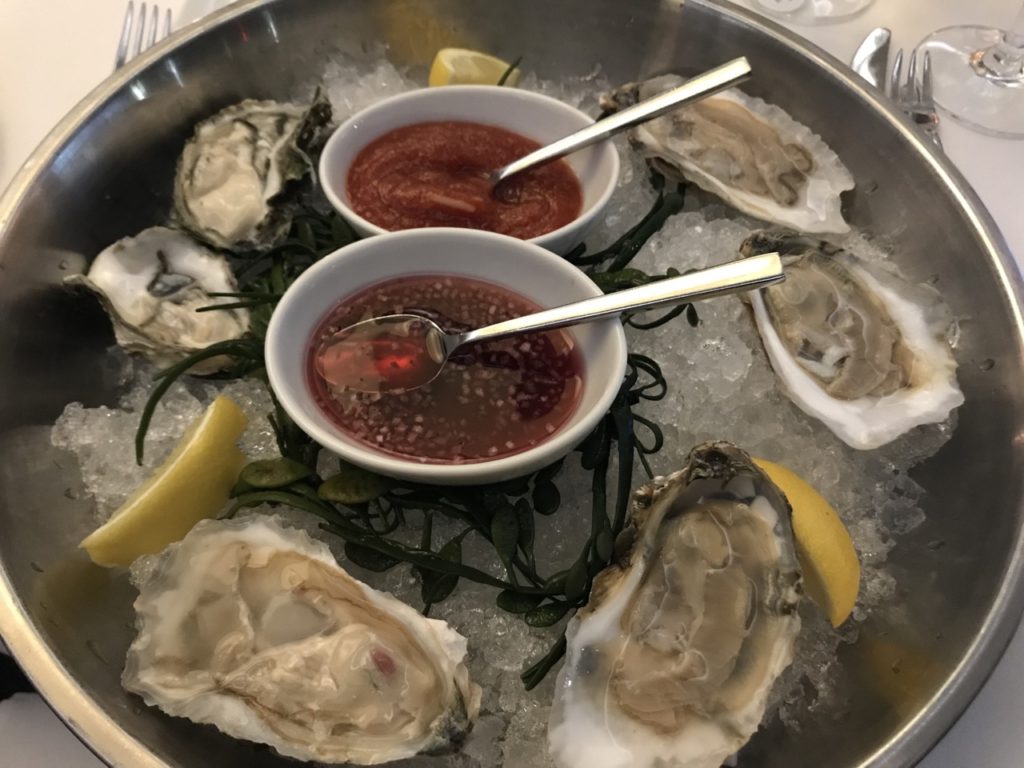In praise of white Burgundy

Dry white outclasses all else
By Panos Kakaviatos for wine-chronicles.com
10 March 2018
Over dinner at the excellent Charlie Palmer Steakhouse in Washington D.C. this past January, which I can only highly recommend, a few wine loving friends put blindfolds on but we would have picked the white blind or not.
As with “blind wine tastings” we decided to conceal the identity of the wines not with blind folds per se but we used aluminum foil to cover the bottles to see if anyone could guess which one was which. Most of us guessed wrong.
But that is hardly news, as blind tastings can be ruthless, even to the most experienced taster.
What was revealed is how fine white Burgundy can – and should – be. The dry white outshined all the other wines we enjoyed.
Too often – still today – one can encounter cases of white Burgundy that is prematurely oxidized, but when everything falls into place, it is pretty difficult to top white Burgundy as a world class wine. Especially when combined with the right food.

We took up the blind tasting challenge! From left to right: Keith Levenberg, David Ehrlich, Chris Bublitz, myself, Robb Johnson, and Darryl Priest.
Tasting Notes
When in bold, I liked in particular. When red and bold, even more. If underlined, too, a wine nirvana!
Wines tasted non blind
Domaine de Chevalier Blanc 1983: Remarkably young color. Nougat like nose. Not very strong honeysuckle, but still there to add a slightly rich aspect. The palate is smooth and somewhat buttery, indeed even lively with decent acidity and energy. A Burgundian aspect, too, of wet stone or rather wet concrete in this case. Later on, just hints of orange blossom and toffee. A real pleasure to drink. Thank you, Darryl Priest for bringing this wine over to dinner. 95/100
Domaine de Chevalier 2007: This exhibited fine salinity, richness and enough energy. Suave aspects to the fruit expression. Not just “grapefruit” or “lemon” but more complex. Developing well enough for its age, but not as nuanced or as interesting as the 1983, or even as one would have expected. Could the bottle have been a less optimal example for the vintage? I was expecting a bit more as least based on other experiences I have had from this vintage and producer.. 91/100
Champagne Pierre Peters 2007: Crisp and fine, but not as rich as one would expect from a 2007 vintage. I had recently enjoyed the opulent and poised Champagne Philipponnat Clos des Goisses 2000, and this was not as impressive, and even somewhat short on the finish. 90/100
Then came the masterpiece. And the wine of the entire dinner evening, blind or not. At least for me. Sometimes one encounters a wine that you want to call perfect. But perfection does not exist in my book.
And the concept seems, well, a bit boring. I like quirkiness: wines that have character by not being too polished, too clean, too, well, “perfect”.
But now we talk about semantics.
I would rather use the word masterpiece and so this next wine was: one of the very best I have had, ever. Living in Alsace, I realize how excruciatingly underrated white Rieslings are still today. And in terms of bang for your buck, you can find more interesting white wines in Alsace. But when white Burgundy is in its top form, it is a masterpiece.
2008 Batard Montrachet Michel Niellon*: The color looks normal for its age, no sign of premature oxidation. And the nose? Gorgeous! There is richness and opulence already on the aromatics. And complexity, with beeswax, white flower, wet stone, hints of exotic fruit, including mango. The palate? Beguiling: nothing short of that. What gorgeous density, without being heavy in any way. And the finish? On and on. A bottle that I could have enjoyed easily twice in one evening. Thanks to Robb for bringing this beauty! 100/100

Just one example of the fine food one can get from Charlie Palmer – and not just the great steaks! This was offered to us because we had to move tables.
Not only was the wine a masterpiece, but the food pairing was great, too: Lobster ravioli with tarragon – see photo below. Of course the ravioli was home-made and tasted so. It came with a vanilla parsnip puree, which lent delectable creamy texture to the food, a texture that the wine echoed.
Blind tasting reds in two flights of three
Château Angelus 1989 and 1998 / Vieux Château Certan 1989 / Château Evangile 1998 / Château Canon 1990 / Château Haut Bailly 1989
Wine A was rich and opulent, modern and even just a tad slutty. Some were thinking Angelus, but it turned out to be the Château Evangile 1998, which was indeed delicious and decadent. Fellow participant Keith Levenberg liked it the most; calling it “spectacular, powerful and exuberant” and it improved in glass. It revealed a dark fruit profile of blackberry and plum but its opulence and succulence was balanced by a fine structure. 95/100
Wine B seemed very refined and round, and very smooth. I was thinking Château Angelus 1998, because of the polish, but it was… Château Canon 1990, which turned out to be quite the crowd pleasing wine of the evening. As Keith noted in his tasting notes: a “very impressive showing” from a period when the property apparently wasn’t in the best shape. “You wouldn’t know it from tasting this,” and indeed most of us did not. It tasted younger than its years. The overall effect was one of refinement and ripeness. One of my favorites of the blind tasting. 96/100
Wine C showed the lightest – and oldest – color, with orange rind, truffle, and a slightly short finish. Many of us were thinking the Canon, as we had in our heads the fact that the estate was not in a “golden era” at that time. But it turned out to be the Vieux Château Certan 1989. Over time, the palate became more intense and improved in glass, but it was a bit short overall and somewhat disappointing for the estate. 91/100
Wine 2A seemed to be classical and elegant as well as opulent. A nice combo! Some of us were thinking if it could possibly be the Haut Bailly… But, no! This was none other than Château Angelus 1989, and it was excellent. Very refined and showing breed and excellent ripe fruit. I recall enjoying this back in 2004 on Nantucket Island. It had more power back then but is aging gracefully. 95/100
Wine 2B This wine had an initially strict aspect, but I liked the wet stone on the nose, along with cedar freshness, even if it seemed somewhat muted when compared to the previous wine. The fruit was not as pronounced to be sure. “Maybe it would have fared better next to the Vieux Château Certan,” said Chris Bublitz. The Château Haut Bailly 1989 was lovely, nonetheless. 91/100
Wine 2C I am glad I guessed correctly on this one, as it was the bottle I had brought: Château Angelus 1998. A lovely wine and superior to the more monolithic 2000 vintage, that I had tried last year. After we revealed the mysteries, we tried the wines again in different pairings. And of course the obvious choice was to compare the 1998 Evangile with this Angelus. The Evangile 98 is comparatively stricter in one sense, but it retains the opulence and richness. The Angelus 1998 is more sumptuous, albeit perhaps a bit less “together” and just a tad drying on the finish, as compared to the Evangile. So in that sense, I grade the Angelus just a bit lower. Still, a very fine Saint Emilion! 94/100
End game
Domaine Trimbach Cuvée Frédéric Emile Vendanges Tardives 1989: Now the final wine for dinner almost upstaged everything else that preceded it. I would say it was my second favorite of the evening, after the mighty white Burgundy. A fine orange color, luminous. A truly pleasing variety of fruit driven aromatics and flavors enchant the taster from the get go: from orange peel to white peach. You get subtle petrol notes and spring flowers, as well, finishing with sweet confected fruit aspects but never heavy handed. Trimbach hits a home run here, as the wine achieves both aromatic complexity – a veritable bouquet – and that happy balance of opulence with vivacity. A long finish in a wine alive and kicking – and tasting more youthful than its vintage could suggest. Bravo! 98/100
Fonseca Vintage Port 1970: What a great way to end the evening of fine wine and food with yet another highlight. Thanks to Chris Bublitz for reminding us all how damn delicious vintage port can be. From memory, as by the time we got to this glorious wine, I was not taking notes, but certainly it conveyed multidimensional fruit-driven characteristics with tertiary spices including and fine dark chocolate. Seductive and creamy to be sure, but the opulence was based on impressive structure that kept the wine serious and long with lift on the finish. 98/100
 Wine Chronicles
Wine Chronicles









Wish I was there! Your group’s range for the dinner inspires me to have our group (of 10) to not stay with just one group of wines, i.e., just red Burgundies.
Thanks for posting! Having one group of wines is useful to compare of course, but it is indeed quite fun to “mix things up”. And in this case, it proved to me at least how much I love white Burgundy.
Just a note: the Durand wine extractor Atlanta Georgia I believe is the best for older wine corks, removed a Cork from 45 mouton with ease: enjoy your ,if you will, down to earth and practical commentary
Doc
Many thanks for your feedback.